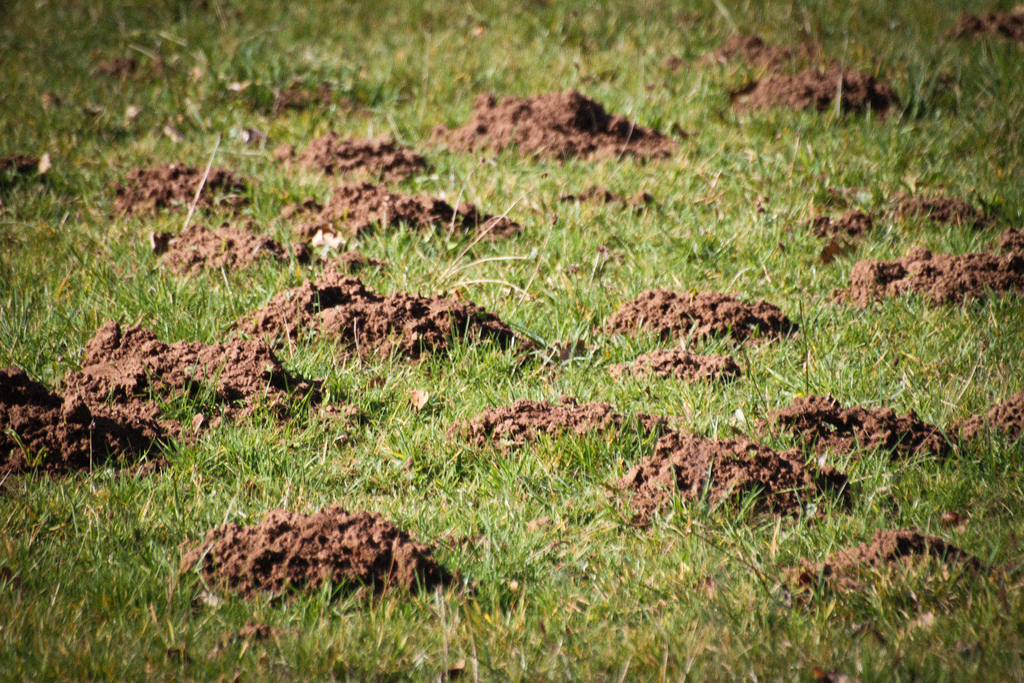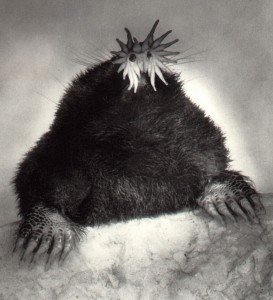Mountains of molehills

Molehills. Photo: Joanne Goldby, Creative Commons, some rights reserved
One thing about snow is that it hides a multitude of sins. A coating of “alabaster wool,” as Emily Dickinson put it, makes one property look as immaculate as the next. By early April, though, most of us felt like pristine is an overrated virtue, and we were prepared to settle for muck and grime if only Mother Nature would peel back her wintry shroud.
But as backyard glaciers receded, some homeowners were dismayed to find that an army of moles had apparently spent the winter detonating explosives. The star-nosed mole and the hairy-tail mole are the two species that live in our area, and as their soil mounds indicate, they’re active all winter. If they’ve turned your once-flat lawn into a relief map of the Adirondacks, don’t panic — it’s not as bad as it seems.

Star-nosed mole. A five-ounce mole can eat about 50 pounds of grubs and worms a year. Photo: Gordon Ramsay, Creative Commons, some rights reserved
It may not change your opinion of them, but moles consume lawn-decimating grubs. In addition to the Japanese beetle, we have four other beetle species whose larval, or grub, stages eat grass roots. Grubs weaken grass and create dead patches, and the moles have been, well, grubbing them out for you. A five-ounce mole can eat about 50 pounds of grubs and worms a year.
Moles also contribute to healthier soils. Their activities help blend material throughout the soil profile, which improves aeration and drainage.
If mole damage becomes severe you may have to implement control measures. Fortunately, as rodents go, moles have a low reproductive rate. While the extent of damage may suggest your yard is teeming with moles, it’s likely there are just two or three. This means you only have to eliminate a few animals to vastly reduce or stop the carnage.
Moles have two kinds of tunnels, permanent ones 6-24 inches deep and temporary ones just below the surface. They’re able to dig new surface tunnels at nearly 20 feet per hour, and can scuttle through their deep runs at about 80 feet a minute. In spring and fall they feed closer to the surface in their shallow runs, and this is the best time to control them.
Mole repellants sometimes work in the short term. Cat feces, coyote or fox urine, and castor oil mixed with dish soap may help drive them off your property for a while. Studies have shown that ultrasonic and vibratory devices meant to repel moles or mice do not work. Remedies such as placing broken glass or mothballs in their tunnels are also useless.
Toxic baits are of limited value, because unless they’re pretty confident it’s a live insect, moles will rarely eat it. The only effective way to remove moles from your yard is by trapping. It’s fairly simple, although it requires a time investment.
Scissor or harpoon-type traps work, but must be set in active surface tunnels. Jab a stick into surface runs every few yards. If the holes are repaired the following day, the tunnel is active and you can set a trap there. Mole traps can be found at most hardware stores or purchased online.
Regardless of how you deal with moles, it’s easy to get rid of their soil piles. Once the ground dries out enough, rake the molehills into the surrounding grass. After a few warm days and a spring shower or two, the lawn will take off and you’d never know the place had suffered an outbreak of tiny volcanoes.
But a strategy of tolerance is cheaper and leaves you more free time if you can live with a little seasonal mess. After all, we’re talking about molehills, not mountains.
Paul Hetzler is a horticulture and natural resources educator with Cornell Cooperative Extension of St. Lawrence County.








Busy as a mole. Busy as a beaver. And how much wood could a woodchuck chuck if a woodchuck could chuck wood?
Thank you, Mr. Hetzler, for another informative and fun piece. Thanks also NCPR for providing the great pictures along with the postings.